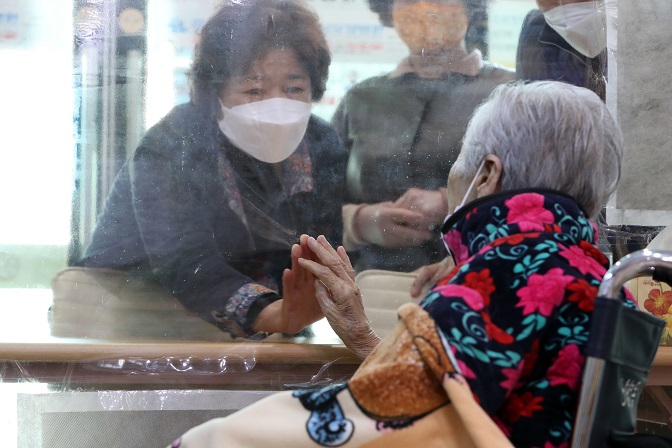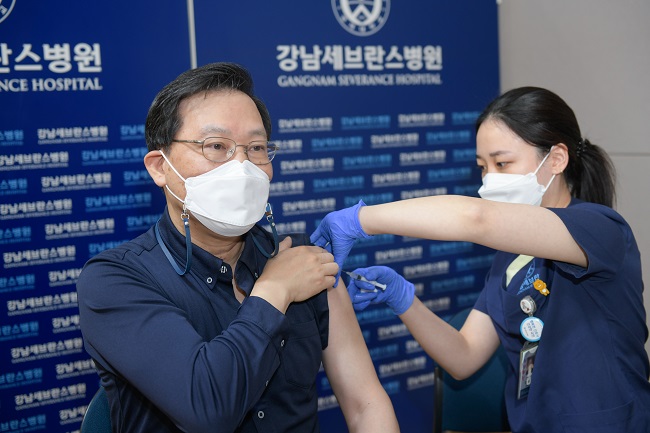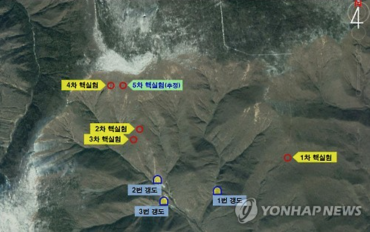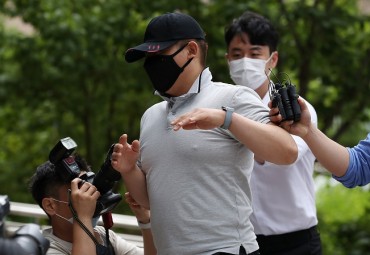
A patient (R) on one side of a transparent screen due to preventative measures against COVID-19 meets with a family member at a senior care hospital in Gwangju, 330 kilometers south of Seoul, on March 9, 2021. (Yonhap)
SEOUL, March 9 (Korea Bizwire) — South Korea’s daily new coronavirus cases bounced back to above 400 on Tuesday as continued cluster infections and increased outdoor activity are feared to ignite another surge in virus infections.
The country reported 446 more COVID-19 cases, including 427 local infections, raising the total caseload to 93,263, the Korea Disease Control and Prevention Agency (KDCA) said.
Daily infections stayed below 400 on Monday apparently due to less testing over the weekend after exceeding the threshold for two days, with 418 cases Saturday and 416 on Sunday.
The number was expected to rise to around 450 on Wednesday, with health authorities and local governments saying 428 new cases were confirmed as of 9 p.m. on Tuesday.
That is 23 more than the same time the previous day. Daily tallies are counted until midnight and announced the next morning.
The country added three more deaths from COVID-19, raising the total to 1,645. The fatality rate was 1.76 percent, the KDCA said.
After peaking late last year, the country’s daily infections have since gradually fallen on the back of tougher virus curbs.
The greater Seoul area is currently under the Level 2 social distancing scheme, the third highest in the country’s five-tier system, while other regions are placed under Level 1.5.
Private gatherings of five or more people are banned nationwide.
The daily tally, however, has recently hovered in the 300s and 400s amid continued cluster infections, most notably at a livestock meat facility in Anseong, 77 kilometers south of Seoul, which added 59 new cases to 77 in total.
Increased outdoor activity amid warmer weather has also put health authorities on edge as it could increase contacts among people.
The current social distancing level will stay in effect until March 14, with authorities likely to announce changes, if any, on Friday.
South Korea is also working to finalize its new four-tier social distancing system by the end of this month.
Health authorities said they will expand the operations of temporary testing stations from the greater capital region to other areas, including Busan, Ulsan, Gwangju, Daegu, Cheonan and Asan.
Virus tests at such facilities will be available through the end of April.
The country has been operating such stations, which allow anyone to test for the virus even without symptoms, in the greater Seoul area since mid-December to step up testing and curb the virus’ spread.
Currently, 98 virus testing centers are available in Seoul and its surrounding regions.
Since the launch of such facilities, a total of 2.42 million virus tests have been conducted, with a total of 6,522 people being confirmed to have been infected through tests at the facilities.

Gangnam Severance Hospital Director Song Young-goo receives a COVID-19 vaccine shot at the hospital in southern Seoul on March 9, 2021, in this photo provided by the hospital.
The country’s vaccination campaign, which started late last month with vaccines from AstraZeneca and Pfizer, is expected to pick up steam.
A total of 383,346 people have been inoculated, including 64,111 the previous day, since the first shot was administered on Feb. 26.
AstraZeneca’s vaccine has been given to 377,138 people, while 6,208 received that of Pfizer.
The number of people reporting adverse effects after receiving shots came to 4,851 so far, up 936 from the previous day.
The majority of them — 924 — were common and mild symptoms, such as headaches or fever, while there were 10 new reports of suspicions of anaphylaxis.
Two more people died after receiving vaccines, bringing the total to 13. A group of experts, however, tentatively concluded Monday that eight of the deaths were unrelated to the vaccinations, with the rest undergoing investigations.
South Korea aims to achieve herd immunity by November.
Of the 427 locally transmitted cases, 98 additional cases were reported in Seoul and 181 in Gyeonggi Province that surrounds the capital. Incheon, 40 kilometers west of Seoul, identified 20 new cases.
The three areas, which make up the greater capital region and serve as home to about half of the nation’s 52 million population, accounted for 70 percent of new local cases.
There were an additional 19 imported cases, raising the total caseload to 7,207.
The number of seriously or critically ill COVID-19 patients was 128, unchanged from the previous day.
The total number of people released from quarantine after making full recoveries was 83,900, up 426 from a day earlier.
South Korea has carried out 6,902,984 COVID-19 tests so far, including 41,175 from the previous day.
(Yonhap)






